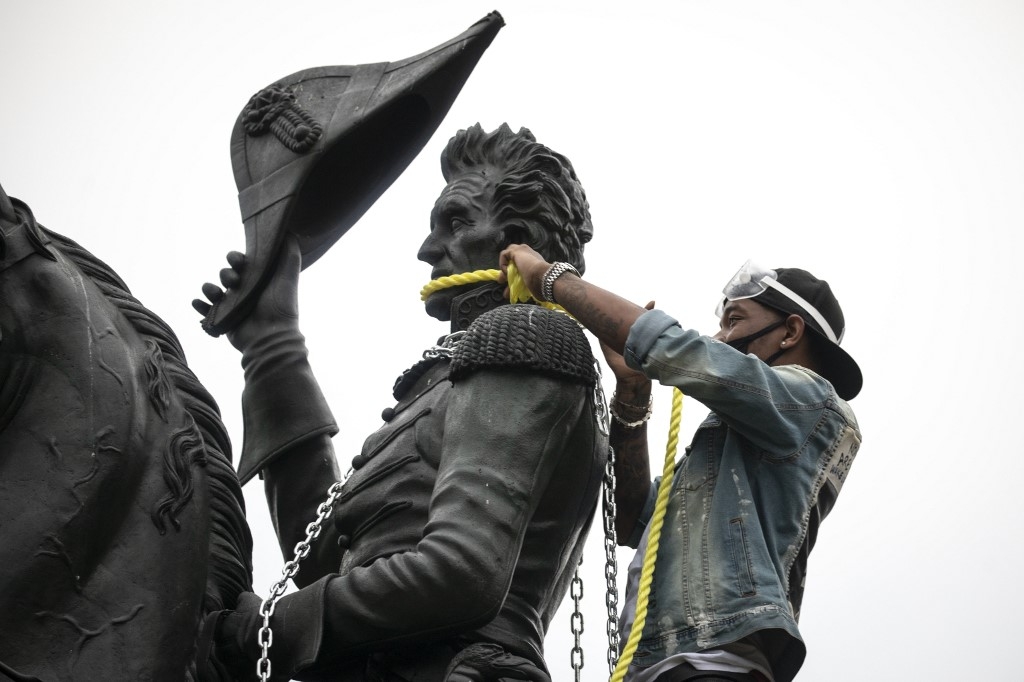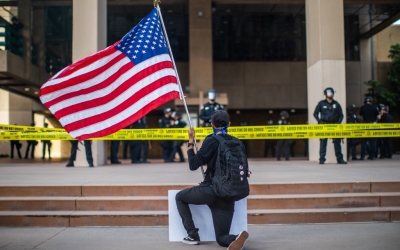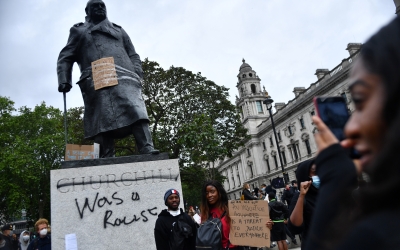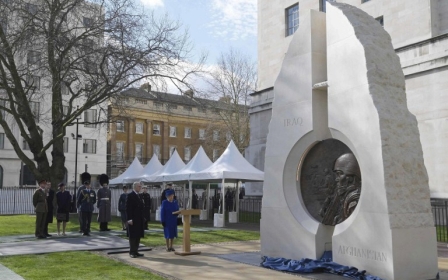Toppling George Washington and the myth of American democracy

In the last few days, statues of George Washington, one of the US founding fathers, have been defaced in recognition of his many crimes - to the horror of liberal and conservative American white supremacists.
Washington was a racist who owned slaves and fought and murdered Native Americans, burning their villages and crops without expressing remorse. He had a lifelong “obsession” with stealing Indian land either for himself or for his settler-colonial republic. He presided over a country that denied women suffrage and only granted the vote to white, property-owning, male colonial settlers.
Most Americans know much of this about him, yet they celebrate him alongside the other slave-owning, Indian-killing founding fathers of their republic. Indeed, most Americans express pride that they named a whole state that their troops conquered from Native Americans in Washington’s honour, in addition to naming their capital city after him.
The American political, intellectual, and journalistic class would never consider removing Washington's name from the capital and the state that bear it despite his horrific crimes, yet many of them celebrated when the Russians changed Leningrad’s name in 1991, even though Lenin, unlike Washington, did not commit genocide, nor owned slaves, nor denied women the vote.
Century of slavery
New MEE newsletter: Jerusalem Dispatch
Sign up to get the latest insights and analysis on Israel-Palestine, alongside Turkey Unpacked and other MEE newsletters
Many of the atrocities the US government committed against its own population are well-known to most US citizens, even if they remain ignorant of many horrifying details. Most Americans know that their country was founded on the theft of Native American land and the genocide of the majority of Native Americans, who were denied citizenship and the right to vote until 1924 and were only able to fully exercise that right after 1948.
Most Americans also know that the first century of the US republic was a century of slavery, and that its second century was a century of legal racial segregation and discrimination against Black Americans. They know, too, that for the first century and a half of their republic, women were denied suffrage, and that for the first half century, white men who did not own property were also denied the right to vote.
White American nationalism and white supremacy are so hegemonic across US mainstream white culture that it renders even most American academics oblivious to the actual nature of their country
Yet, with all this historical knowledge, which in its large contours is not denied in official US history, most Americans - including the US government, mainstream media, and US public and private schools and universities - assert without flinching that their country has been a “democracy” since 1776, by which they mean that it has been a democracy for white, property-owning men.
When you confront these Americans with the fact that their acknowledgement of these historical facts, coupled with their claims that their country has always been a “democracy”, show them to be white-male-supremacists, they are often taken aback - as if they had never thought of the dissonance and incongruence of these contradictory claims.
White-male-supremacist 'democracy'
Indeed, white American nationalism and white supremacy are so hegemonic across US mainstream white culture that it renders even most American academics oblivious to the actual nature of their country.
During my first year studying for my PhD at Columbia University, I posed the question during class of this incongruence to one of my liberal white professors, who kept insisting during her lecture that the US had been a democracy since 1776 and was the only democracy in the world at the time.
Her strident and proud nationalist answer to my question was: “Can you find another country that was more democratic during this period?” That her answer could not imagine the meaninglessness and absurdity of a white-male-supremacist democracy to the majority of the world’s peoples, let alone to the majority of the US population, as something that signifies “freedom” is yet another demonstration of such nationalist commitments.
It is in this context of a commitment to an official white supremacist history that the ongoing uprising in the US should be viewed, especially as it relates to the more recent insistence by participants that many of the statues in the country that glorify white supremacy and slavery must be removed, destroyed, or both.
Christopher Columbus, to take the most extreme example of a genocidal conqueror, remains a hallowed name in the US (indeed, my own university, formerly King’s College, was renamed after him in 1784 as a form of direct affiliation, as “Columbia” had become one the names by which the United States was known - though luckily, Columbia University does not celebrate the federal holiday, Columbus Day, established in 1934 by former President Franklin Roosevelt).
Glorifying Confederate generals
While white Americans celebrated Columbus early on, it was at the end of the 19th century that he was appropriated by Italian Americans, mostly immigrants from Sicily and southern Italy, who suffered much racial discrimination in the US on account of having a dark complexion - so much so that some of them were lynched in 1891 in New Orleans by white supremacists.
In appropriating Columbus, right-wing Italian Americans found their ticket to enter the club of whiteness and white supremacy: that they, too, had participated in the conquest of the Americas and the genocide of Indigenous peoples.
Similarly, white racist Hispanics in the state of New Mexico were appalled last week that Native Americans and Chicanos and their allies removed the statue of the genocidal Spanish conqueror Juan de Onate from downtown Albuquerque. I still remember my horror as a teenager that one of the buildings of the University of New Mexico, my college alma mater, had a building named after Onate to honour the man responsible for the massacre of the Acoma Indian people in 1599. Onate Hall shamelessly remains named after him to this day.
As for the statues of Confederate generals, including that of the racist slaver Robert E Lee - one of whose statues was erected in Virginia as late as 1924 - these generals fought a secessionist war against the US to maintain slavery, in what is known as the American Civil War.
Their continued celebration in the form of statues in the northern and southern US is testimony to the persistence of the hegemony of the white supremacist version of US history. The majority of their statues were erected not before the Civil War, but indeed decades later to support the racist segregationist system called Jim Crow, and during the 1950s and 1960s to assert white supremacy against granting civil rights to Black Americans.
'Denying who we are'
We find the same pride in European countries of their colonial history. In France, where protesters are questioning the continued glorification of the country’s genocidal and racist colonial history, neoliberal French President Emmanuel Macron swiftly asserted that “the republic will not erase any trace, or any name, from its history ... it will not take down any statue” of its colonial war criminal officials. To do so, he claimed, would amount to “denying who we are”.
These war criminals are acceptable to Macron, because he is aware that the majority of white French citizens, unlike non-white French citizens, glorify their colonial and genocidal history
Yet, the French had no problem after World War II erasing the name of Marshal Philippe Petain, even though he was a hero of the battle of Verdun during World War I. However, his collaboration with the Nazis during WWII and leading of Vichy France rendered Petain a veritable traitor. Erasing his name from streets continued until 2011 - though Macron wanted to honour him two years ago, had he not been stopped by Jewish protests. Monuments glorifying Petain, however, remain in New York City.
Why does Petain deserve to be “erased”, but not the war criminal Marshal Hubert Lyautey, or General Henri Gouraud, or Philippe Leclerc, or Jean Etienne Valluy, or so many other colonial officials who committed unspeakable crimes in the Caribbean, Africa, the Arab world and Indochina?
These war criminals are acceptable to Macron because he is aware that the majority of white French citizens, unlike non-white French citizens, glorify their colonial and genocidal history and identify with it, while most learned to disidentify with Petain because he victimised white people - and arguably because scapegoating and vilifying Petain serves to erase and absolve the collaboration of vast numbers of other white French people with the Nazis.
Toxic, idol-worshipping nationalism
Similarly, British Prime Minister Boris Johnson has asserted in the face of massive demonstrations targeting his country’s racist and genocidal colonial history, and the continued glorification of colonial officials, that to remove their statues would be “to lie about our history”.
On the contrary, what protesters are demanding is a correction of the false history that Britain continues to uphold and wherein it glorifies genocidal and racist criminals, including Winston Churchill, who authorised the use of chemical weapons against anti-colonial Iraqis in 1920 and against Russian revolutionaries in 1919, and was responsible for the famine in Bengal in 1943 that killed millions. Churchill also advocated the use of poison gas against Indian anti-colonialists, but was appalled that India Office officials were too “squeamish” to follow his directives.
Why should non-white British, or French, or American citizens - let alone white anti-colonial and anti-racist citizens - accept what white racist citizens (and brown and black collaborators with the establishment) want to glorify in their history?
The statues of these criminals are part of the toxic, idol-worshipping American, British and French nationalisms that remain committed to white supremacy, slavery and colonial conquest. Removing them and/or destroying them is no more than a partial corrective to the institutionalised false historical memory that they propagate - and a small step towards a possible redefinition of what Americanness, Frenchness and Britishness should mean.
The views expressed in this article belong to the author and do not necessarily reflect the editorial policy of Middle East Eye.
Middle East Eye delivers independent and unrivalled coverage and analysis of the Middle East, North Africa and beyond. To learn more about republishing this content and the associated fees, please fill out this form. More about MEE can be found here.







